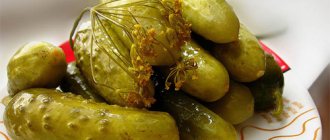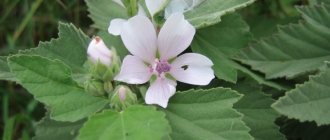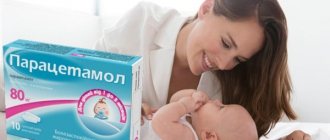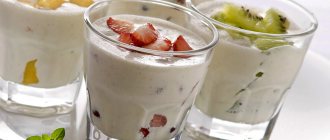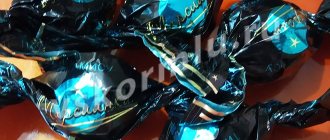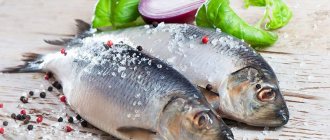Release form and composition
Dosage form of Espumisan baby - drops for oral administration: emulsion with a slight viscosity of the structure, milky-white color, with a characteristic banana odor (30 ml each in a dark glass bottle, equipped with a dropper dispenser, in a cardboard box 1 bottle complete with a measuring cap).
1 ml drops contain:
- active ingredient: simethicone – 0.1 g;
- auxiliary components: liquid sorbitol (non-crystallizing), macrogol stearate 40, carbomer, glyceryl monostearate 40-55, acesulfame potassium, sodium chloride, sodium hydroxide, sodium citrate, sorbic acid, banana flavor, purified water.
Pharmacological properties
Pharmacodynamics
Espumisan baby is a drug to reduce the amount of gases in the gastrointestinal tract (GIT). Its mechanism of action is based on the ability of simethicone to reduce surface tension at the interface between liquid and gaseous media. The surfactant properties of simethicone promote the fusion of gas bubbles and cause the destruction of foam in the intestines. The released gas is absorbed or, under the influence of intestinal peristalsis, is excreted naturally. The use of the drug during preparation for examinations of the abdominal organs allows one to obtain accurate diagnostic data and avoid image defects caused by gas bubbles.
Pharmacokinetics
After oral administration, simethicone is not absorbed from the gastrointestinal tract. The chemical inertness of the active substance allows it to act only in the lumen of the gastrointestinal tract. The drug does not affect the digestive processes because it does not interact with bacteria and enzymes.
It is excreted unchanged through the intestines.
Indications for use
- symptoms of intestinal colic in infants;
- flatulence, increased gas formation in the period after surgery, as well as other symptoms of excessive formation and accumulation of gases in the gastrointestinal tract;
- symptoms of excessive gas formation against the background of functional dyspepsia;
- preparation for examination of the abdominal and pelvic organs using ultrasound, radiography, esophagogastroduodenoscopy and other diagnostic tools, including in the form of an additive to contrast agents to obtain images using the double contrast method;
- acute poisoning with detergents that contain tensides (foaming agents).
Analogues: what can be replaced?
At network points there are similar compositions. The same pharmacological classification includes:
- Baby cadm;
- Bobotik;
- Plantex;
- SubSimplex.
It’s worth finding out which is more effective, Bobotik or Espumisan for newborns.
Bobotik
An analogue of Espumisan for newborns was produced by a Polish pharmaceutical company. The main difference between the medications is reflected in the fact that Bobotik is prohibited from treating an infant who is under 28 days old. Also, the 2 medications differ in the list of auxiliary ingredients and shelf life. Bobotik must be kept in the first aid kit at a temperature of 15 to 25°C. For 30 ml the buyer will pay 250 rubles. Prices are for 2020.
Plantex
Plantex contains completely harmless ingredients:
- fennel ether;
- dry fennel extract;
- acacia gum;
- dextrose;
- lactose.
The drug relieves increased gas formation and accompanying symptoms. It helps to improve the process of bowel movement and relieves the baby from pain. A contraindication to use was found - the presence of galactosemia, glucose absorption and individual perception of the components.
Two drugs provide good relief from increased gas levels and abdominal pain. They belong to different pharmacological groups and include different active ingredients. Plantex contains many natural ingredients, fruits and extracts of fennel. It is described as relieving spasms. Espumisan is a carminative drug.
Despite the fact that two medications are prescribed for the same diseases, their action and indications are slightly different. Plantex is prescribed for colic, constipation and flatulence, and the second drug is aimed at reducing the increased concentration of gases. If an infant is allergic to Espumisan, it is recommended to replace it with Plantex.
You can give Plantex and Espumisan to your baby at the same time. But the main thing is to follow the recommended dosage.
IMPORTANT: When deciding whether to give preference to Plantex or Espumisan, you need to remember that the first medication is made using plant extracts and extracts, and the active substance of Espumisan is a synthetic compound.
Instructions for use of Espumisan baby: method and dosage
Espumisan baby drops are taken orally before, during or after each meal and, if necessary, before bedtime.
Before each dose, the contents of the bottle must be shaken.
To dispense the drug in drops, use a dropper-dispenser (holding the bottle vertically with the hole down), and in milliliters, use a measuring cap.
The frequency of administration and duration of treatment are selected individually, taking into account the severity of symptoms.
If necessary, the use of Espumisan baby is indicated for a long period.
Recommended dosage for the treatment of infant colic in children aged 0 to 1 year: 5-10 drops before, during or after each feeding. The drug is given to the child using a small spoon or added to a bottle of baby food.
The recommended single dosage of Espumisan baby for the treatment of excessive gas formation has age restrictions:
- children 1–6 years old: 10 drops;
- children 6–14 years old: 10–20 drops;
- patients 14–18 years old: 20 drops.
Frequency of application – 3–5 times a day.
In preparation for x-rays, ultrasound and other diagnostic studies, Espumisan baby is prescribed on the eve of diagnosis in a dose of 1 ml 3 times a day after meals and 1 ml in the morning on the day of the examination.
To obtain a double contrast image, add 2–4 ml drops per 1000 ml of contrast suspension.
Before the actual esophagogastroduodenoscopy, the patient is allowed to take 2-3 ml of the drug orally. If it is necessary to eliminate gas bubbles that interfere with endoscopy, 2–3 ml of emulsion can be injected through the endoscope channel.
For the treatment of acute poisoning with detergents containing detergents, the use of 1–4 ml drops is indicated, depending on the severity of intoxication.
How to give espumizan to a newborn while breastfeeding
Espumisan has a wide spectrum of action . Its peculiarity is that the drug can be used even by newborns. Although it is available without a prescription, you should consult your doctor before using it. Indications may be the following:
- Bloating, gas, colic;
- Flatulence, heartburn;
- Poisoning;
- Preparing for an ultrasound.
As a rule, doctors prescribe the drug if colic torments the baby every day ; dill water, massage and warm diapers do not help. In severe cases, pediatricians recommend not waiting for the situation to worsen, but giving medicine at every feeding (up to five times a day) for several weeks.
If colic torments a child every day, the pediatrician prescribes medicine.
It is also worth noting that Espumisan acts as a sedative, after which the child quickly falls asleep.
Required dosage
Before giving the drug to a baby, you need to understand the dosage . It doesn’t matter whether the child is breastfed or bottle-fed, the scheme should be as follows:
Espumisan 40
- Children from birth to 6 years – 5 ml;
- From 6 to 14 years – 10 ml;
- Adults – 10–15 ml.
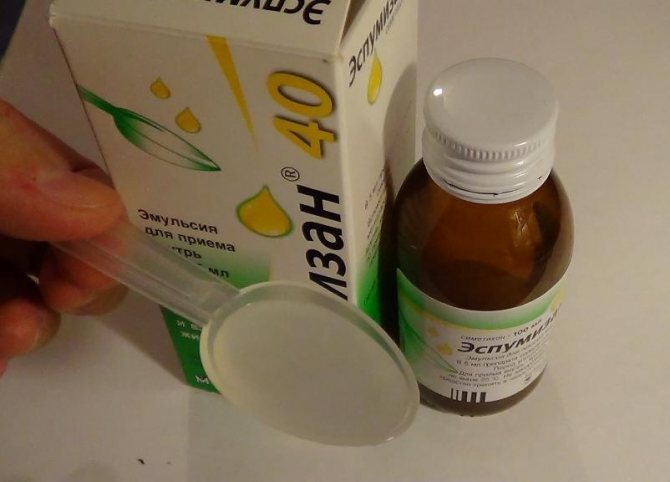
Newborns should be given 5 ml. medications.
The maximum dose at one time is indicated above. Doctors do not recommend using the drug more than 5 times a day.
Espumisan L
- Children under 6 years old – 1 ml (this is 25 drops of the drug);
- Children from 6 to 14 years old – 2 ml;
- Adults – 2–2.5 ml.
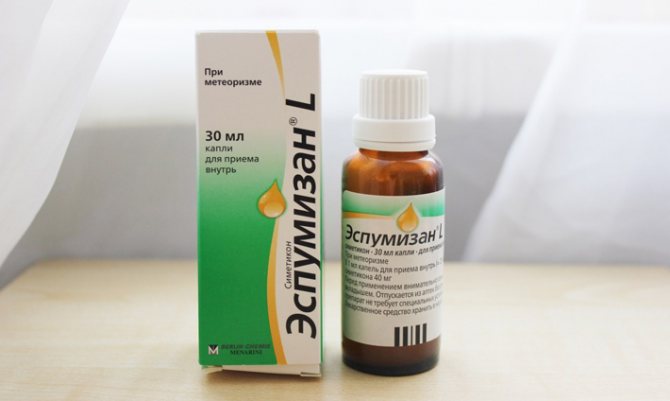
The drug Espumisan L should be given to children over 6 years of age 2 ml.
If the child is breastfed, Espumisan should be given using a measuring spoon or syringe. If the baby refuses to take it, you can mix it with milk. But adding the product to water is not recommended.
For bottle-fed children, the drug is added to the mixture. As a rule, these children have more pronounced problems.
special instructions
If colic and/or excessive gas formation persists in infants after prolonged use of Espumisan Baby, you should consult a doctor. A medical examination may be required to diagnose the cause of the child's illness.
For children with hereditary fructose intolerance, the use of Espumisan baby drops is contraindicated, since the drug contains liquid sorbitol (sorbitol).
Patients with diabetes mellitus should take into account the content of 0.199 g of sorbitol in 1 ml (25 drops) of emulsion, which is equivalent to 0.017 XE (bread unit).
Impact on the ability to drive vehicles and complex mechanisms
According to the instructions, Espumisan baby does not affect the patient’s ability to drive various vehicles and mechanisms.
Reviews of Espumisan baby
Reviews about Espumisan baby are mixed. Some parents, confirming the effectiveness of the drug, write that the drops saved them from sleepless nights. They gave the drug to the child before he started crying from abdominal cramps, in the evening before bed. For babies with more frequent pain, bloating and intestinal colic, it is recommended to use the drug several times during the day. The therapeutic effect of the drops largely depends on the diet of the nursing mother and the individual characteristics of the child.
Other parents note with regret the complete absence or short duration of action of Espumisan baby for newborns and small children. However, everyone points to the pleasant taste of the drops and the convenient dispensing device for use.
Contraindications
Everyone has their own contraindications to the use of Plantex and Espumisan.
Espumisan
- hypersensitivity to fructose;
- individual intolerance to individual components of the drug and allergic reactions to them;
- intestinal obstruction.
Plantex
- lactose intolerance (lactose, galactose, glucose intolerance);
- hypersensitivity to individual components of the drug and allergic reaction to them.
Which of the above drugs to use or not to treat a baby is up to the parents themselves to decide, since every child is individual and each one needs to select a specific composition of drugs.
All these medicines are natural based and only individual intolerance can be a clear contraindication. Again, the cause of abdominal pain should be taken into account, since not all of them can be solved by taking medications.
Video review of all medications for colic in a newborn:
23 Dec 2020 Valeria 386
Share this post
We recommend reading along with this article
- How to give Plantex to newborns - use, safety
- Balanced diet and proper nutrition during breastfeeding
- Similak Premium: composition, feeding schedule, reviews
- The drug Creon: side effects and dosage for children
- Espumisan for newborns: characteristics and features...
- The effectiveness of the drug SAB Simplex for colic in newborns
- Intestinal infections and other unfavorable factors - how...
- Can Miramistin be used during pregnancy and how?
- Menu for a 7 month old baby: recommendations for the correct…
Discussion: there is 1 comment
- Matveeva:
12/26/2017 at 02:40We use Espumisan in our family, both for children and adults. Although parents are more committed to “traditional medicine” in the form of teas and infusions. I am against it because I trust medications.
Answer
